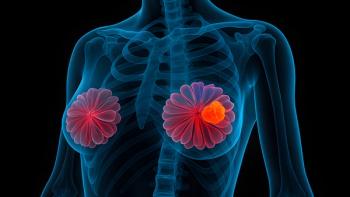
Relacorilant/Nab-Paclitaxel Is Convenient, Safe in Ovarian Cancer
In addition to a significant PFS benefit vs nab-paclitaxel alone, the combination provides an at-home option for patients with ovarian cancer.
Relacorilant plus nab-paclitaxel (Abraxane) significantly increased progression-free survival (PFS) and was well tolerated for patients with ovarian cancer, regardless of platinum-resistance or biomarker status, and is more convenient for patients, according to Alexander Olawaiye, MD.
Olawaiye, a professor of gynecologic oncology at the University of Pittsburgh, and Magee-Womens Hospital of UPMC, Pittsburgh, Pennsylvania, presented findings from the phase 3 ROSELLA trial (NCT05257408) at the 2025
Additionally, he emphasized that the regimen is an oral therapy that allows patients to spend less time at treatment facilities. The PFS benefit showed an improvement of 30% vs nab-paclitaxel alone, which Olawaiye noted was regardless of biomarker status.
Transcript
We’re very excited because the use of relacorilant combined with nab-paclitaxel does not require biomarker selection, which means there is no special testing that needs to be done for a patient to be eligible for this combination when it becomes available. Simply, the patients that are eligible are those who have been treated for ovarian cancer and who have platinum-resistant ovarian cancer.
This is the most exciting thing. It’s also very dose-convenient because it’s [in the form of] a pill; the patient can use the pill in the comfort of their own home and only come into the hospital for infusion.
The safety data was also very good. The relacorilant combination with nab-paclitaxel was very well tolerated. Most of the adverse events that were seen on the trial were ones that are known to be associated with nab-paclitaxel. The number of adverse events that led to discontinuation of therapy was very infrequent and actually balanced on the 2 arms of the study, so it was a very well-tolerated regimen.
The study had 2 primary end points that were dual primary end points. One is progression-free survival, and another is overall survival. We can now share that the progression-free survival endpoint was met. The study showed a hazard ratio of 0.7, which is 30% reduction in the risk of progression or death, which was highly statistically significant.
This transcript has been edited for clarity and conciseness.
Reference
- L, Gilbert L, et al. ROSELLA: A phase 3 study of relacorilant in combination with nab-paclitaxel versus nab-paclitaxel monotherapy in patients with platinum-resistant ovarian cancer (GOG-3073, ENGOT-ov72). J Clin Oncol. 2025;43(suppl 17):LBA5507. doi:10.1200/JCO.2025.43.17_suppl.LBA5507
- Olawaiye AB, Gladieff L, O’Malley DM, et al. Relacorilant and nab-paclitaxel in patients with platinum-resistant ovarian cancer (ROSELLA): an open-label, randomised, controlled, phase 3 trial. Lancet. Published online June 2, 2025. doi:10.1016/S0140-6736(25)01040-2
Newsletter
Knowledge is power. Don’t miss the most recent breakthroughs in cancer care.
















































































